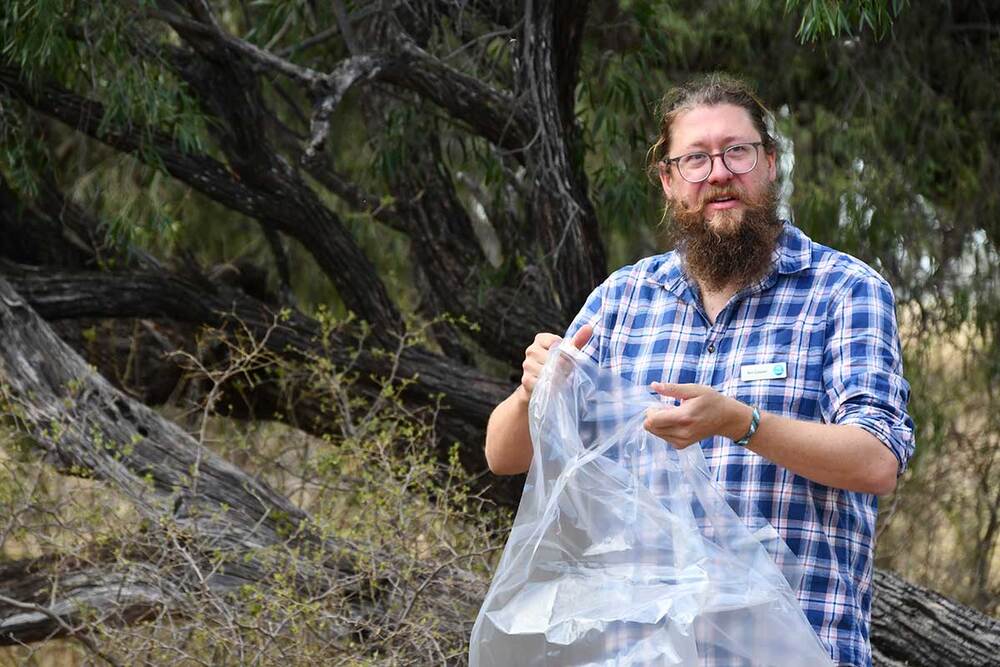Landholders turn out to tackle boxthorn
Coonamble Times
15 March 2024, 2:40 AM

Bloody African boxthorn.
Everyone’s least favourite shrub has been wreaking havoc since it was first introduced in the mid-1800s, however, a non-chemical ally is being brought in to aid farmers in the fight.
As part of a statewide project, the Commonwealth Scientific and Industrial Research Organisation (CSIRO) in partnership with NSW Local Land Services (LLS) are preparing to introduce a rust fungus to combat the reproduction rates of the pesky plant.
The project is currently in its implementation phase in Coonamble, so LLS organised a field day to promote the new fungus and equip farmers with the know-how to use this new biological control.
Held at Chris and Jim Parsons property ‘Milton’ along the Quambone Road on Thursday 7 March, it quickly became apparent how big an issue African Boxthorn is.
Sixty stakeholders took the time to attend the demonstration by CSIRO Weed Management Team Leader Dr Ben Gooden.
“I didn’t anticipate such interest in the program,” said Dr Gooden in regard to the numbers present.
“The goal of the program is to reduce the rate of reproduction, but it (the fungus) won’t eradicate boxthorn.”
Later that day Dr Gooden gave detailed information at the Coonamble Bowling Club.

PHOTO: Dr Ben Gooden from the CSIRO instructed landholders on the release of the rust fungus that is expected to slow the spread of African Boxthorn.
African Boxthorn reproduces faster in Australia than it does in South African according to Dr Gooden, which left researchers with no choice but to introduce a “natural enemy” of the shrub.
“The goal for us was to go to South Africa to find out if any of the natural enemies over there could be introduced here,” said Dr Gooden. “We went over and tested the enemies and found that the fungus only grows on Boxthorn so it wasn’t a threat to anything else.”
“If it was we would never have gotten clearance to release the fungus in Australia.”
While Dr Gooden says the program will come with added short term benefits for farmers, the focus remains on providing a long term solution to the issue.
“In the short term over a four week period the leaves are killed if the fundus establishes itself in the plant,” said Dr Gooden. “The focus for everyone though should be on the long term.”
“If the fungus establishes itself like we hope it will, it should reduce reproduction rates.”
“However, this won’t happen overnight.”
“If you think of some of the best weed management programs, Skeleton weed took a decade, Hudson pear is getting there and it’s been seven years already, and Patterson’s Curse which is highly regarded as one of the best management efforts globally took over thirty years.”
To begin the fungus release phase, landholders in four areas of NSW are being invited to take part in the trial, including Coonamble Shire.
Other areas stretch from Forbes to Young, from Hay to Deniliquin, and the Eden-Monaro areas.
“These areas were identified as being problem areas,” said Dr Gooden.”
How do you join?
To take part in the program you can contact Local Land Services and they will put you in touch with the relevant people.
However, there are a few steps involved.
“This is usually what turns people off,” said Dr Gooden.
The fungus is mixed with purified water and sprayed on the plant “to the point where you can see it covered.” From there you cover the soaked leaves with a clear plastic bag provided.
It is recommended that this process takes place later in the afternoon on days cooler than 30 degrees. In the morning it is important to take the bag off the plant.

Landholders watch the CSIRO demonstration on the release of the rust fungus on boxthorn. IMAGE: Coonamble Times
“You can only use clear bags, the fungus won’t infect if it is covered in a black bag.”
The program is set to finish in 2026, by which time the CSIRO and LLS hope to achieve the following goals.
“We want to establish the fungus - which would be an excellent outcome,” said Dr Gooden. “We want to understand the conditions best suited to infection of the African boxthorn.”
“We also want to measure the decline in boxthorn health.”



